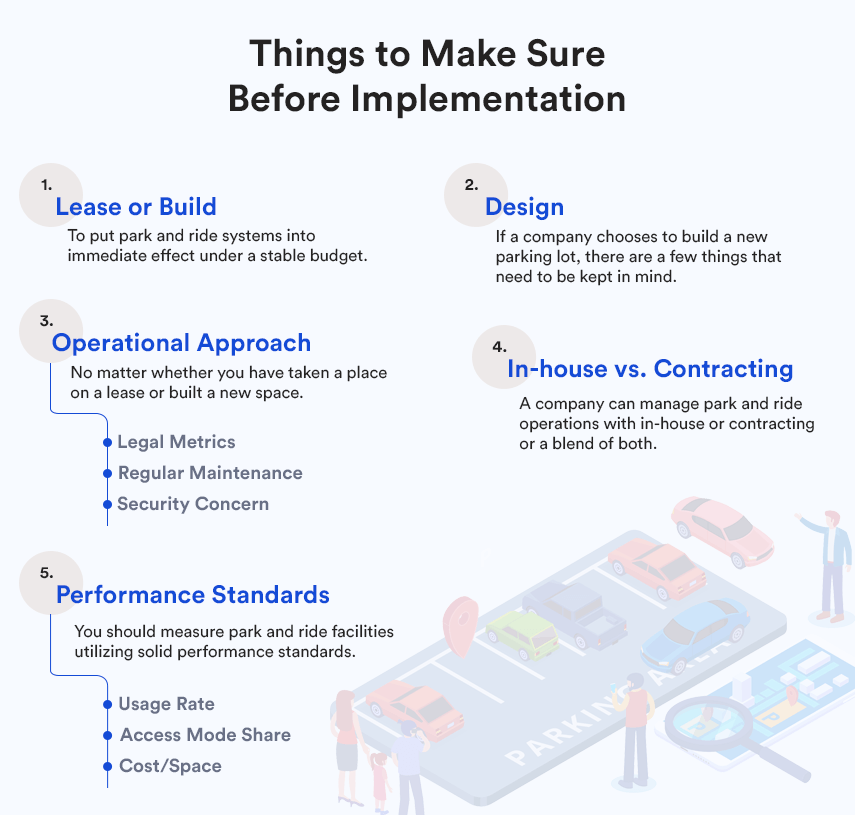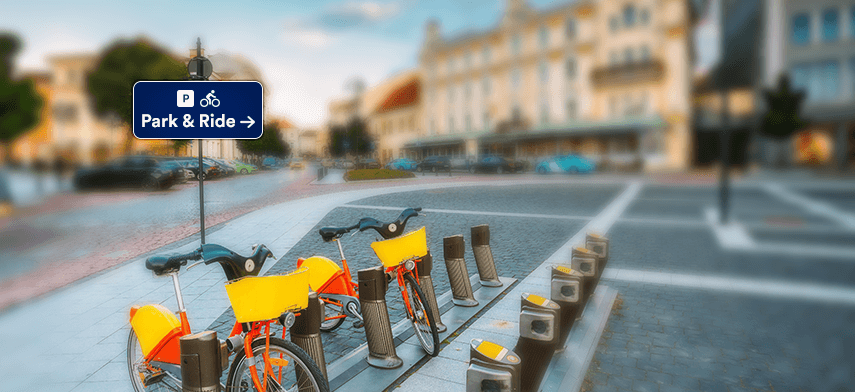Parking in developed and populated urban areas is often a point of concern and quite time-consuming. There is a range of options available to solve parking problems. Talking about the most effective solutions to minimize the traffic volume and reduce the congestion in parking areas, park and ride service is a technology-driven system that should be mentioned.
The main objective here is to facilitate parking lots where private transport users park their own vehicles and commute via public transportation mode. As a result, usage of public transport increases, traffic congestion and air pollution decrease, mobility around a city improves and the commuters can reach their destinations in a stress-free way. City authorities around most parts of the world have already started offering this intermodal urban mobility solution and improving the efficiency of transit.
Does your city also need this system? Today’s post will give you the answer. This post is all about making you understand the importance of the park and ride system for seamless intermodal urban public transportation.
Key Components and Objectives of Park and Ride Service
A properly planned park and ride system provides solutions to meet transport needs in a sustainable way. The main reason to implement a park and ride system is to minimize on-street parking while striking a balance between profit and maintenance costs. This measure comprises of three major components, which are:
- The launching of a new park and ride solution along with improving the existing ones
- Making public transport connections better
- Developing an electronic system that can help people in advance booking of parking spaces
The main objectives behind it are:
- Improving mobility in urban areas
- Encouraging people to choose public transport
- Reducing pollution and traffic congestion
To make the park and ride service safe, the process needs to be integrated with a video surveillance system in the parking spot. The facilities available are controlling access, paying through an automated system, parking bikes on racks with intelligent lock systems, and charging of electric bikes. People who avail of these services can ride their own bikes or opt for bike-sharing service which means they can rent a bike (both regular and electronic). After implementing the system, a testing period is needed to be followed.

Implementation of Park and Ride Facility
However, the basic concept of the park and ride is pretty simple. But without proper planning, implementation, and maintenance it cannot be done perfectly. Hence, here are some of the best practices that you should keep in mind to make the most of these facilities:
- Choose an area that is easily accessible to you. Park and ride facilities can be successfully offered when the parking spot is peripheral, an outer area away from the regular traffic congestion. The location should also provide direct access to the public transport system. Therefore, identify ideal locations and select the best out of those.
- Reanalyze the transit frequency. Offering this facility does not mean that you should stop analyzing transport patterns regularly. You should closely monitor transit activity, at least once in a quarter.
- Keep planning new strategies to make sure the service keeps evolving with time. Implement the new ones along with the existing ones.
- Never forget to collect and channelize support of the public and stakeholders to educate commuters about the incredible benefits of Park and Ride solution.
Park and ride services have been offered in many areas around the globe for a long time. But just a few years ago, when the number of vehicles on streets around the world started growing immensely and a solution was urgently required, the true worth of this intermodal urban mobility solution was acknowledged. And how! A well-implemented park and ride system can make traveling hassle-free, and save time and money for commuters. Decreasing the pollution level is an additional advantage. Therefore, this is the time when spreading this service to as many urban areas as possible has become a necessity.

A detailed implementation plan is required once the decision of investing in a park and ride system for a particular area is made. Make sure that a park and ride system should be safe, convenient and well-organized. When implemented correctly, a park and ride can perfectly fit the definition of the intermodal urban mobility system. In fact, the US federal government, in assistance with various administration departments, through Intermodal Surface Transportation Efficiency Act, has already given importance to multimodal and intermodal projects like Park and Ride facility over other options that make people depend on private vehicles across urban areas.
As the world has started embracing this intermodal public transportation service, you should also be updated with its implementation process before planning to invest in it.
There are various considerations that can be followed during its implementation; some of these are discussed below:
1 Lease or Build
To put park and ride systems into immediate effect under a stable budget, some companies opt for leasing existing parking lots instead of constructing new ones. Spaces from public organizations, shopping malls, theaters, etc. can be leased. It is a less hazardous and cheap short-term option but has drawbacks too. With prior short notice, any lease agreement can be terminated. As a result, the companies may find it difficult to organize the parking supply in the same way that their customers have grown trusting on. On the other hand, building a new space for parking enables the companies to design it precisely to its requirements.
2 Design
If a company chooses to build a new parking lot, there are a few things that need to be kept in mind. The most important among all is to decide what type of parking is required. Other than offering standard parking spaces for vehicles, there should be spaces accessible for disabled. Also, there should be separate areas for bicycles, carpool vehicles, and pick-up/drop-off facilities. A parking structure partially depends on the cost of land. Building surface parking lot costs less, especially in low-density places. If a land value rises considerably, opting for underground parking can be cost-effective.
3 Operational Approach
No matter whether you have taken a place on a lease or built a new space. Without running a constant operational approach for this, a Park-and-Ride cannot serve successfully for a long time. Such an approach includes:
- Legal Metrics
To maintain a well-organized park and ride system, you should set rules for users’ behavior and display these prominently in the area. These rules must state who can park and for how long. Any type of forceful usage can be handled by local police, any other legal authorities, or company staff. If there is a particular insurance liability associated with your Park-and-Ride, you must factor the cost into your operating expense and carefully track all the claims.
- Regular Maintenance
Most companies, offering this service, usually have basic maintenance requirements, such as trash cleaning, electrical system, and general repair facilities. Additional amenities, such as customer waiting areas, staff restrooms, etc. have extra maintenance requirements.
- Security Concern
This is an important concern that ensures protection for the lots, staff and users. At the basic level, CCTV cameras should be used to monitor the area. Hiring security guards for patrolling the area can provide extra protection. At an advanced level, dedicated on-site security can be appointed. Also, proactive and timely security checks can find out various risks, like blocked surveillance cameras, broken lights, etc.
4 In-house vs. Contracting
A company can manage park and ride operations with in-house or contracting or a blend of both the facilities. The in-house operation allows companies to have more control than contracting. However, it needs thorough staffing. On the other hand, the contracting facility makes the service provider stress-free because all the operational and maintenance activities get managed by the contractors.
It would be only logical to go through your existing resources and calculate the expense of both in-house and contracting options. Only after that take a final call. Some regular activities, such as customer assistance, parking charge collection, security, etc. can be managed in house whereas other activities like landscaping, repair, etc. can be outsourced. Every company has different requirements and resources. So, one should make a decision about operations accordingly.
5 Performance Standards
You should measure park and ride facilities utilizing solid performance standards. Below are three measurable standards, used for evaluating the system performance.
- Usage Rate - This denotes how much of the parking spaces are occupied by how many cars for a particular amount of time. Once or twice a year, counting this rate with the help of automatic counters is enough to keep you aware of whether your parking space capacity meets the demand or not.
- Access Mode Share - By evaluating it, you can have a rough idea about the number of riders uses your facility by different modes like biking, driving alone, being dropped off or carpooling.
- Cost/Space - By calculating this accurately, you can evaluate your resource requirements and manage operations in an organized way.
Now as you have got an overview of the implementation of a park and ride system, let’s talk about its advantages.
Advantages of Implementing the Park and Ride System
Below are the major advantages of implementing a Park and Ride System:
- It increases the usage of transit and ridesharing, which eventually decreases the number of single-person occupied vehicles or personal vehicles on busy streets. When the commuters reach their destinations in an easier way via carpool, bus or train, they would be encouraged to use the service more frequently.
- It can be considered as an alternative to personal car travel. Especially the commuters from suburban areas can considerably rely on transit service-centered at an easy-to-access Park and Ride lot.
- In park and ride system, most transport options, such as buses, cars, etc. are often equipped with Wi-fi facilities. Thus, while commuting, passengers can manage time and focus more on work and personal things instead of wasting time in traffic congestion.
- It minimizes fuel consumption and vehicle emissions.
- It improves mobility by providing optional transportation options.
- It can be used for shuttling people to special events.
In a nutshell, a properly implemented park and ride system makes transit service efficient, reduces air pollution, and saves cost.
Wrapping it up
The main agenda of this article on park and ride services is to explain that it is a convenient way to get around without taking the stress of driving and finding a place to park your vehicle in busy urban areas. One just needs to park a vehicle at the Park and Ride lot and take a ride to reach a particular destination. With its bounteous advantages in today’s world, the service is here to stay.
So, if your aim is to make public commute hassle-free while making profits, launch a park and ride system. Connect with your customers through an app as well. Make your service available for people with just a tap.





 March 3, 2020
March 3, 2020


